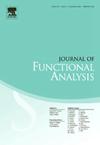凸性,傅里叶变换,格点差异
IF 1.6
2区 数学
Q1 MATHEMATICS
引用次数: 0
摘要
在Bruna, Nagel和Wainger的一篇著名的论文中,证明了有限直线型光滑超曲面的傅里叶变换衰减估计。在本文中,我们将他们的结果推广到以下几个方面。首先,对于局部是凸实解析函数图的曲面,我们证明了即使所讨论的曲面不是有限线型,自然模拟也成立。其次,我们给出了一个一般曲面的结果,该曲面局部是凸C2函数的图,或者是由实解析方程定义的这样一个曲面的一部分,它在许多情况下隐含了一个类似的傅里叶变换衰减定理,其中振荡指标小于1。在这种情况下,对于紧曲面,所提供的指数是尖锐的。这一结果对我们所描述的点阵差异问题具有启示意义。本文章由计算机程序翻译,如有差异,请以英文原文为准。
Convexity, Fourier transforms, and lattice point discrepancy
In a well-known paper by Bruna, Nagel and Wainger [5], Fourier transform decay estimates were proved for smooth hypersurfaces of finite line type bounding a convex domain. In this paper, we generalize their results in the following ways. First, for a surface that is locally the graph of a convex real analytic function, we show that a natural analogue holds even when the surface in question is not of finite line type. Secondly, we show a result for a general surface that is locally the graph of a convex function, or a piece of such a surface defined through real analytic equations, that implies an analogous Fourier transform decay theorem in many situations where the oscillatory index is less than 1. In such situations, for a compact surface the exponent provided is sharp. This result has implications for lattice point discrepancy problems, which we describe.
求助全文
通过发布文献求助,成功后即可免费获取论文全文。
去求助
来源期刊
CiteScore
3.20
自引率
5.90%
发文量
271
审稿时长
7.5 months
期刊介绍:
The Journal of Functional Analysis presents original research papers in all scientific disciplines in which modern functional analysis plays a basic role. Articles by scientists in a variety of interdisciplinary areas are published.
Research Areas Include:
• Significant applications of functional analysis, including those to other areas of mathematics
• New developments in functional analysis
• Contributions to important problems in and challenges to functional analysis

 求助内容:
求助内容: 应助结果提醒方式:
应助结果提醒方式:


